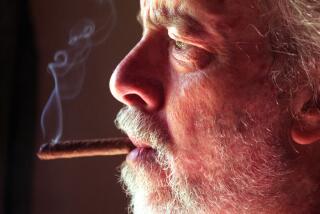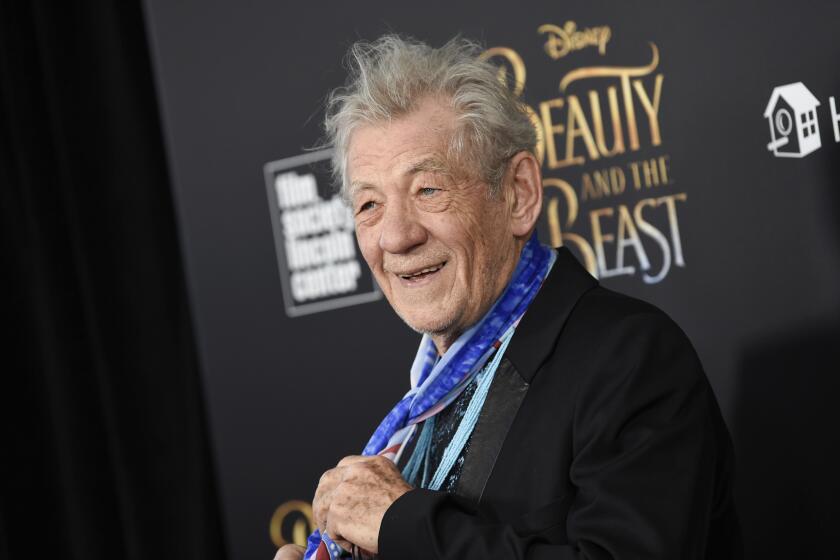ART REVIEW : The Eccentric Buddhist Vision of Ito Jakuchu, Greengrocer and Artist
An exhibition of Japanese paintings that caused a stir last fall in New York recently arrived at the Los Angeles County Museum of Art. “The Paintings of Jakuchu,” which features an astonishing range of works by one of 18th-Century Japan’s authentically great individualists, is certain to captivate aficionados as well as visitors who just wander into the museum.
Jakuchu’s colorfully painted scrolls depicting flora and fauna are so profusely detailed and brilliantly designed that they defy imagining how any mere human being could have created them. At the opposite extreme is his breathtakingly minimal series of six ink-on-paper scrolls called “Lotus Pond.” The quiet scene melts away into a central space that appears to be empty but is actually filled with the specter of death and winter.
Between these two poles of Jakuchu’s sensibility are relatively crude paintings of clay dolls, striking woodblock prints of bright birds on velvety black backgrounds and--seriously--a funeral scene portraying the dead Buddha as a radish surrounded by mourning vegetables.
There’s a certain logic to “Vegetable Parinirvana,” the improbable and apparently irreverent death scene. Ito Jakuchu (1716-1800) was the son of a greengrocer and ran the family’s wholesale business for 17 years before he became a full-time artist at 40. He may have been more at home with the mushrooms, persimmons, yams and cucumbers in his parody than with human characters. An assiduous observer of nature, Jakuchu also raised chickens and elevated them to lofty heights of grace and beauty in his paintings.
Environment may account for some of his subject matter, but there’s no explaining the innovative talent and brilliant eccentricity that has distinguished Jakuchu in the annals of Japanese painting. A born artist, he was ill-suited to business and eventually unloaded that burden on a younger brother. Jakuchu had classical training in Japanese painting and drew inspiration from Chinese painters, but he developed such an unusual style that he stands out as an eccentric.
One wonders how he got away with it, but in fact he was highly regarded during his life. Jakuchu had the good fortune to live in Kyoto during a peaceful time when a spirit of experimentation and individuality was in vogue.
He initially gained fame for his masterpiece--a series of 30 vividly painted scrolls known as the “Colorful Realm of Living Beings.” Painted from about 1757 to 1765, the scrolls are a pictorial encyclopedia of plants and animals interpreted according to Jakuchu’s vision of peace and prosperity. He presented the scrolls in 1765 to Shokukuji, a Zen temple in Kyoto. They are part of the Imperial Household Collection and are rarely put on public exhibition.
Examples currently on display in Los Angeles are panels called “Mandarin Ducks in Snow,” “Hydrangeas and Fowl,” “Fish in a Lotus Pond,” “Golden Pheasants in Snow” and “Birds and Peonies.” All are poetic marriages of flora and fauna, so closely entwined that they seem to be of a piece. Striking in composition--characterized by sweeping curves and rhythmic repetition--the scrolls are skillfully detailed down to the last detail of the last feather.
These color paintings represent one major component of Jakuchu’s work. The other is ink paintings that reveal the artist’s devotion to Zen. Strictly speaking, however, the ink paintings do not conform to Zen principles. Despite their enormous energy and directness, they are more calculated, less spontaneous in feeling than classical Zen works.
Jakuchu was a lay Zen priest, so his affinity to the philosophy’s artistic precepts are expected. But he was also such an individualist that he inevitably came up with his own style. It is typified by such ink paintings as “Two Roosters and a Hen” and “Pine, Plum and Crane,” which contrast dramatic shapes and patterns with open space.
About 45 works, on loan from Japanese collections, are on view on the lower floor of the Ahmanson Building, but they are only the beginning of a three-course Jakuchu banquet. Because of Japanese government regulations and the fragility of the works, “The Paintings of Jakuchu” is being presented in two parts. Part I continues through Jan. 14. Part II will be shown from Jan. 18 to Feb. 18. Each portion contains a full chronological range of the artist’s work, so that visitors who only see one part can grasp the whole of his oeuvre .
The third course of the banquet is an auxiliary exhibition (to Feb. 18) in the Japanese Pavilion. “The Colorful Realm of Jakuchu and Jakuen” consists of works by the master and his most prominent student, Jakuen, from American collections. The Metropolitan Museum of Art in New York, the Denver Art Museum and four private collectors have loaned pieces that complement the County Museum of Art’s extensive Jakuchu collection.
More to Read
The biggest entertainment stories
Get our big stories about Hollywood, film, television, music, arts, culture and more right in your inbox as soon as they publish.
You may occasionally receive promotional content from the Los Angeles Times.






